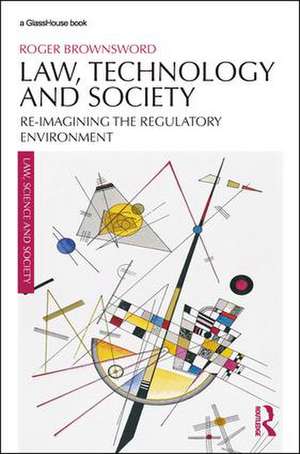Law, Technology and Society: Reimagining the Regulatory Environment: Law, Science and Society
Autor Roger Brownsworden Limba Engleză Paperback – 25 feb 2019
In an era of smart regulatory technologies, how should we understand the ‘regulatory environment’, and the ‘complexion’ of its regulatory signals? How does technological management sit with the Rule of Law and with the traditional ideals of legality, legal coherence, and respect for liberty, human rights and human dignity? What is the future for the rules of criminal law, torts and contract law—are they likely to be rendered redundant? How are human informational interests to be specified and protected? Can traditional rules of law survive not only the emergent use of technological management but also a risk management mentality that pervades the collective engagement with new technologies? Even if technological management is effective, is it acceptable? Are we ready for rule by technology?
Undertaking a radical examination of the disruptive effects of technology on the law and the legal mind-set, Roger Brownsword calls for a triple act of re-imagination: first, re-imagining legal rules as one element of a larger regulatory environment of which technological management is also a part; secondly, re-imagining the Rule of Law as a constraint on the arbitrary exercise of power (whether exercised through rules or through technological measures); and, thirdly, re-imagining the future of traditional rules of criminal law, tort law, and contract law.
| Toate formatele și edițiile | Preț | Express |
|---|---|---|
| Paperback (1) | 373.59 lei 6-8 săpt. | |
| Taylor & Francis – 25 feb 2019 | 373.59 lei 6-8 săpt. | |
| Hardback (1) | 1000.27 lei 6-8 săpt. | |
| Taylor & Francis – 26 feb 2019 | 1000.27 lei 6-8 săpt. |
Preț: 373.59 lei
Nou
Puncte Express: 560
Preț estimativ în valută:
71.49€ • 76.44$ • 59.60£
71.49€ • 76.44$ • 59.60£
Carte tipărită la comandă
Livrare economică 17 aprilie-01 mai
Preluare comenzi: 021 569.72.76
Specificații
ISBN-13: 9780815356462
ISBN-10: 0815356463
Pagini: 361
Dimensiuni: 156 x 234 x 19 mm
Greutate: 0.54 kg
Ediția:1
Editura: Taylor & Francis
Colecția Routledge
Seria Law, Science and Society
Locul publicării:Oxford, United Kingdom
ISBN-10: 0815356463
Pagini: 361
Dimensiuni: 156 x 234 x 19 mm
Greutate: 0.54 kg
Ediția:1
Editura: Taylor & Francis
Colecția Routledge
Seria Law, Science and Society
Locul publicării:Oxford, United Kingdom
Cuprins
CONTENTS
Preface
Prologue
Preface
Prologue
- In the Year 2061: From Law to Technological ManagementPart One: Re-imagining the Regulatory Environment
- The Regulatory Environment: An Extended Field of Inquiry
- The ‘Complexion’ of the Regulatory Environment
- Three Regulatory Responsibilities: Red Lines, Reasonableness, and Technological ManagementPart Two: Re-imagining Legal Values
- The Ideal of Legality and the Rule of Law
- The Ideal of Coherence
- The Liberal Critique of Coercion: Law, Liberty and TechnologyPart Three: Re-imagining Legal Rules
- Legal Rules, Technological Disruption, and Legal/Regulatory Mind-Sets
- Regulating Crime: The Future of the Criminal Law
- Regulating Interactions: The Future of Tort Law
- Regulating Transactions: The Future of Contracts
- Regulating the Information Society: The Future of Privacy, Data Protection Law and ConsentEpilogue
- In the Year 2161
Notă biografică
Roger Brownsword has professorial appointments in the Dickson Poon School of Law at King's College London and in the Department of Law at Bournemouth University, and he is an honorary Professor in Law at the University of Sheffield.
Descriere
This book considers the implications of the regulatory burden being borne increasingly by technological management rather than by rules of law. If crime is controlled, if human health and safety is secured, if the environment is protected, not by rules but by measures of technological management, what should we make of this transformation?
















